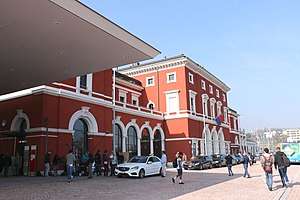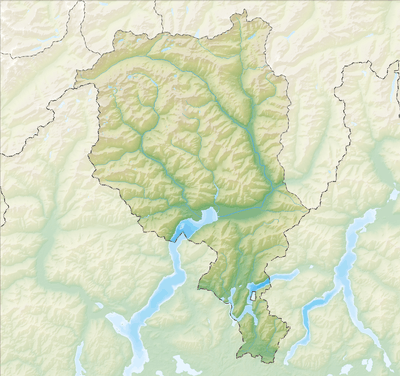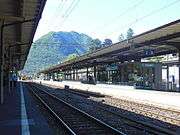Lugano railway station
Lugano railway station (Italian: Stazione di Lugano) is the main railway station of the city of Lugano, in the Swiss canton of Ticino. The station is on the Gotthard railway and is also the terminus of the Lugano Città–Stazione funicular. The metre gauge Lugano–Ponte Tresa Railway (FLP) has a separate station at Lugano FLP railway station across the station forecourt from the main line station.[1][3]
Lugano | ||||||||||||||||||||||||||||||||||||||||||||||||
|---|---|---|---|---|---|---|---|---|---|---|---|---|---|---|---|---|---|---|---|---|---|---|---|---|---|---|---|---|---|---|---|---|---|---|---|---|---|---|---|---|---|---|---|---|---|---|---|---|
 The station building in 2017 | ||||||||||||||||||||||||||||||||||||||||||||||||
| Location | Piazzale della Stazione Lugano Switzerland | |||||||||||||||||||||||||||||||||||||||||||||||
| Coordinates | 46°0′19.836″N 8°56′48.761″E | |||||||||||||||||||||||||||||||||||||||||||||||
| Elevation | 334 m (1,096 ft) | |||||||||||||||||||||||||||||||||||||||||||||||
| Owned by | Swiss Federal Railways | |||||||||||||||||||||||||||||||||||||||||||||||
| Line(s) | Gotthard line | |||||||||||||||||||||||||||||||||||||||||||||||
| Distance | 180.5 km (112.2 mi) from Immensee[1] | |||||||||||||||||||||||||||||||||||||||||||||||
| Platforms | 4 | |||||||||||||||||||||||||||||||||||||||||||||||
| Tracks | 4 | |||||||||||||||||||||||||||||||||||||||||||||||
| Train operators | ||||||||||||||||||||||||||||||||||||||||||||||||
| Connections | ||||||||||||||||||||||||||||||||||||||||||||||||
| Other information | ||||||||||||||||||||||||||||||||||||||||||||||||
| Fare zone | 10/100 (Arcobaleno) | |||||||||||||||||||||||||||||||||||||||||||||||
| History | ||||||||||||||||||||||||||||||||||||||||||||||||
| Opened | 6 December 1874 | |||||||||||||||||||||||||||||||||||||||||||||||
| Electrified | 6 February 1922 | |||||||||||||||||||||||||||||||||||||||||||||||
| Traffic | ||||||||||||||||||||||||||||||||||||||||||||||||
| Passengers (2018) | 18,600 per working day[2] | |||||||||||||||||||||||||||||||||||||||||||||||
| Rank | 44 of 1735 | |||||||||||||||||||||||||||||||||||||||||||||||
| Services | ||||||||||||||||||||||||||||||||||||||||||||||||
| ||||||||||||||||||||||||||||||||||||||||||||||||
| Location | ||||||||||||||||||||||||||||||||||||||||||||||||
 Lugano Location within Switzerland  Lugano Lugano (Canton of Ticino) | ||||||||||||||||||||||||||||||||||||||||||||||||
The station is situated on a hillside to the west of the city centre, overlooking the city and Lake Lugano, and the funicular provides a direct link from the station to the city centre below. The residential quarter of Besso lies above and to the west of the station.[4] The station is nicknamed Terrazza del Ticino ("Terrace of Ticino") since the opening of the Gotthard Base Tunnel in 2016.[5]
History
The Gotthard railway's station was opened in 1874, as part of that railway's Lugano to Chiasso line. By 1882, with the opening of the line across the Monte Ceneri Pass to Bellinzona, and the Gotthard Rail Tunnel beyond that, Lugano was connected with the rest of the canton of Ticino and with northern Switzerland.
The Lugano Città–Stazione funicular opened in 1886, and was followed by the Lugano–Tesserete railway (LT) in 1909, and the Lugano–Ponte Tresa railway (FLP) in 1912. The LT operated from a terminus and depot to the north-east of the main station, whilst the FLP constructed a terminus at a lower level to the south-east of the main station. Additionally, in 1910, a branch of the city's urban tramway was extended to the station forecourt.[6][7][8]
Until 1927 the station formed a barrier between the city to one side, and the suburb of Besso to the other. However, in that year a road tunnel and pedestrian subway were constructed under the railway, which allowed the extension of the city's trams to Besso. In 1943, Piazzale di Besso was created to the west of the station.[9]
The Lugano tramway closed in the 1950s. The Lugano–Tesserete railway closed in 1967, and the site of its station is now occupied by the regional bus stop and turning circle at the northern end of the station forecourt. The first section of its trackbed now forms a pedestrian ramp down to Via S. Gottardo, and the site of its depot is a car park.[6]
In 1998 a project was initiated to improve the railway station facilities and the surrounding areas, designed by the architect Aurelio Galfetti. This has included the redevelopment of the forecourt of the station, especially in terms of pedestrian safety. In 2007 the station underpass was restored, and a third (northern) platform was constructed, which allows access to the station from the north.
Facilities
The station is owned and operated by the Swiss Federal Railways. It contains four tracks, arranged with flanking side platforms and a central island platform. The main station buildings are on the platform on the city centre side of the station, but there is also access from the Besso side of the station to the adjacent platform. Both of these platforms, and the island platform between them, are linked by two pedestrian underpasses.[10]
In front of the station is a large forecourt, from which traffic other than buses and taxis is excluded. Local buses of the Trasporti Pubblici Luganesi (TPL) operate from the southern end of the forecourt, whilst regional buses of the AutoPostale and Autolinee Regionali Luganesi operate from the northern end. The station to city funicular, also operated by TPL, runs from a platform directly adjacent to the main station building, descending in tunnel under the forecourt.[10]
The station does not include any freight handling facilities. Freight in the Lugano area is handled through the Lugano Vedeggio freight yard, constructed in the 1970s and accessed via a branch from the Gotthard railway near Taverne-Torricella station.[1]
 Funicular seen from main line platform
Funicular seen from main line platform Regional bus stop on the site of the LT terminus
Regional bus stop on the site of the LT terminus- Lugano main line station building prior to the 2016-17 renovation
Services
Located near the southern end of the Gotthard railway, Lugano is served by long distance trains from northern Switzerland, principally Zurich and Basel, including EuroCity trains to Milan in Italy. It is also served by local trains of the Treni Regionali Ticino Lombardia (TILO).
The following services stop at Lugano:[11]
- EuroCity/RegioExpress: hourly or better service to Milano Centrale.
- EuroCity/InterCity: hourly service to Zürich Hauptbahnhof.
- EuroCity/InterCity: service every two hours to Basel SBB.
- RegioExpress: hourly service most of the day to Bellinzona, with most trains continuing from Bellinzona to Erstfeld.
- S10/S50: half-hourly service between Bellinzona and Mendrisio; hourly service from Mendrisio to Chiasso, Como San Giovanni, or Malpensa Aeroporto Terminal 2.
The Lugano Città–Stazione funicular, one of Switzerland's busiest funicular lines, runs continuously from 05:20 to 23:50, seven days a week.[7]
Selected city bus routes of the Trasporti Pubblici Luganesi (TPL), and some regional routes of the AutoPostale and Autolinee Regionali Luganesi (ARL), serve the station. However the main hubs of Lugano's bus network are elsewhere, with TPL and ARL serving a city centre bus station a few minutes walk from the lower terminus of the funicular, and AutoPostale using an underground bus station to the north of the city centre.
 View from main line platform 1 to south
View from main line platform 1 to south View from main line platform 1 to north
View from main line platform 1 to north
References
- Eisenbahnatlas Schweiz. Verlag Schweers + Wall GmbH. 2012. p. 59. ISBN 978-3-89494-130-7.
- "Passagierfrequenz (2018)". Berne, Switzerland: SBB CFF FFS. 7 October 2019. Retrieved 2019-11-06 – via data.sbb.ch – SBB DATA PORTAL.
- Moser, Beat; Pfeiffer, Peter (2004). SBB Gotthardbahn (in German). Fürstenfeldbruck, Germany: Eisenbahn-Journal (Verlagsgruppe Bahn GmbH). ISBN 3-89610-121-8.
- map.geo.admin.ch (Map). Swiss Confederation. Retrieved 2012-06-29.
- "Lavori in corso alla porta che ci conduce al futuro". gdp.ch. Giornale del Popolo. 6 August 2015. Retrieved 7 December 2016.
- "Lugano–Tesserete". www.eingestellte-bahnen.ch (in German). Retrieved 2012-10-26.
- "TPL - Funicolare Lugano - Stazione" (in Italian). Trasporti Pubblici Luganesi SA. Retrieved 2012-09-05.
- "Storia" [History] (in Italian). FLP. Archived from the original on 2013-05-03. Retrieved 2012-10-18.
- "Storia del quartiere di Besso" [History of Besso] (in Italian). City of Lugano. Archived from the original on 2012-11-10. Retrieved 2012-10-29.
- "Piano interno della stazione di Lugano" [Lugano station plan] (PDF) (in Italian). Swiss Federal Railways. Retrieved 2012-06-29.
- "Erstfeld - Airolo - Bellinzona - Chiasso - Milano" (PDF) (in Italian). Bundesamt für Verkehr. 4 November 2019. Retrieved 28 June 2020.